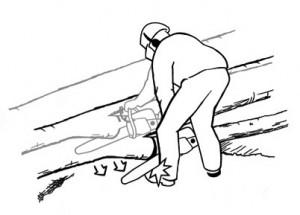BACKGROUND: On a sunny, cool day in the Appalachians, a chain saw operator was topping a large yellow-poplar tree that he had just felled.
PERSONAL CHARACTERISTICS: The 41-year-old chain saw operator’s normal function on the logging crew was to stump and top trees. He had 16 years of logging work experience, and he was considered fully trained to perform his duties safely and effectively. He was wearing personal protective equipment.
UNSAFE ACTS & CONDITIONS: The operator’s work boots did not contain any specialized chain saw cut-resistant material. The large, felled poplar tree was lying on a sidehill and across a small gully. The operator began topping a 10-inch-diameter limb about 50 feet up the tree trunk. This 10-inch limb was under pressure due to the gully it was lying across; the operator failed to realize that the limb was a stored energy source.
ACCIDENT: The operator cut downward into the 10-inch-diameter limb until he noticed that his chain saw was beginning to get stuck. He pulled the chain saw out of the limb and cut the limb the rest of the way from the bottom side. When the saw completed the cut, the limb fell rapidly onto the chain saw and forced the saw onto the operator’s left foot just above the ankle.
INJURY: The chain saw cut through the boot and lacerated the top of his left foot above the ankle. The operator waved to get the attention of the dozer operator, who helped the injured employee onto the dozer and transported him to the log deck. The injured operator was then transported by the owner to the local hospital. He underwent surgery and was expected to undergo follow-up treatment for his injuries. At the time of the injury, his amount of lost work time was undetermined.
RECOMMENDATIONS FOR CORRECTION:
- Trees should be closely inspected prior to topping and delimbing, and workers should position themselves such that no limb or branch or movement of the trunk will cause injury.
- Employers should ensure that their employees who operate chain saws wear chain saw cut-resistant footwear and all personal protective equipment that is required by OSHA.
- Employees should be trained in compression and tension wood scenarios in the logging woods and use proper body placement along with top-lock and limb-lock techniques.
 Courtesy of the Forest Resources Association: https://www.forestresources.org/
Courtesy of the Forest Resources Association: https://www.forestresources.org/
